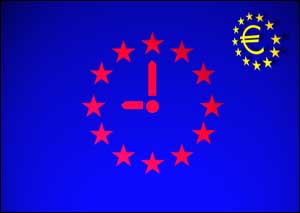
Monday, November 10, 1997 Published at 17:46 GMT
Emu timetable: a single European currency by 2002?

July 1, 1990
Stage one of Economic and Monetary Union (Emu) begins. Capital movements in the EU Member States are fully liberalised (except where temporary derogations have been granted).
The single market is completed in most areas.
November 1, 1993
Stage two of Emu begins:
- The Composition of the ECU (European currency) basket is frozen
- The Treaty on European Union, signed in Maastricht, enters into force.
January 1, 1994
- The European Monetary Institute (EMI) is set up in Frankfurt.
- Procedures for co-ordinating economic policies at European level are strengthened.
- Member States strive to combat ‘excessive deficits’ and to achieve economic convergence as described by the Maastricht criteria.
December 15 and 16, 1995
At the Madrid European Council:
- The name ‘euro’ is adopted for the single currency.
- A technical scenario for the introduction of the euro and a timetable for change-over to the single currency in 1999 is finalised. (End of the process scheduled for 2002).
December 13 and 14, 1996
At the Dublin European Council:
- Pact on Stability and Growth is agreed. It sets the framework within which monetary policy will be co-ordinated after the launch of the single currency.
1997
- The EMI specifies the regulatory, organisational, and logistical framework for the European Central Bank (ECB) and the European System of Central Banks (ESCB) on January 10.
- The European Commission, Council, and EMI prepare the legislation on the ECB and ESCB and on the introduction of the single currency.
February 1998
- European Commission and EMI report to Council of finance ministers (ECOFIN) on convergence
- France, Germany, Italy, Belgium, the Netherlands, Luxembourg, Austria, Spain, Portugal, Finland and Ireland announce that they expect to hit the targets for economic convergence.
By May 2, 1998
- Member States appoint Executive Board of the European Central Bank, and decide which countries will be in the first wave to join Emu.
Spring/Summer 1998
- ECB and Council set the date for introduction of euro notes and coins.
- ESCB starts issuing banknotes in euros
- Council and Member States start minting euro coins.
Before January 1, 1999
Final preparation of the ECB and ESCB:
- Council to adopt legislation on the key for capital subscription, collection of statistical information, minimum reserves, consultation of the ECB, and fines and penalties which can be imposed on undertakings.
- ECB and ESCB to get ready for becoming operational: setting up the ECB, adopting the regulatory framework, testing the monetary policy framework, etc.
January 1, 1999
Stage three of Emu begins
- Council to fix irrevocably the conversion rates of the currencies of participating countries both among themselves and against the euro.
- The euro is to become a currency in its own right and the official ECU basket will cease to exist.
- Council regulation establishing the legal framework for introduction of the euro is to enter into force.
From January 1, 1999
- European System of Central Banks to frame and implement single monetary policy in euros and conduct foreign exchange operations in euros.
- Member States to issue new public debt securities in euros.
- ‘No compulsion, no prohibition’ on private sector use of the euro.
- National currency banknotes may be exchanged at central banks at official fixed exchange rate.
From January 1, 1999 to July 1, 2002 at the latest
- ESCB to exchange at official rate currencies with irrevocably fixed conversion rates.
- ESCB and public authorities in Member States to monitor changeover developments in the banking and finance sectors and assist the whole of the economy to prepare for the changeover.
July 1, 2002 at the latest
- ESCB gradually to put euro notes into circulation and withdraw national banknotes.
- Member States gradually to put euro coins into circulation and withdraw national coins.
- The changeover to the euro is complete in all the participating member states.
![]()
![]()
![]()

Back to top | BBC News Home | BBC Homepage | ©
![]()
![]()
![]()
![]()
![]()
![]()
![]()



